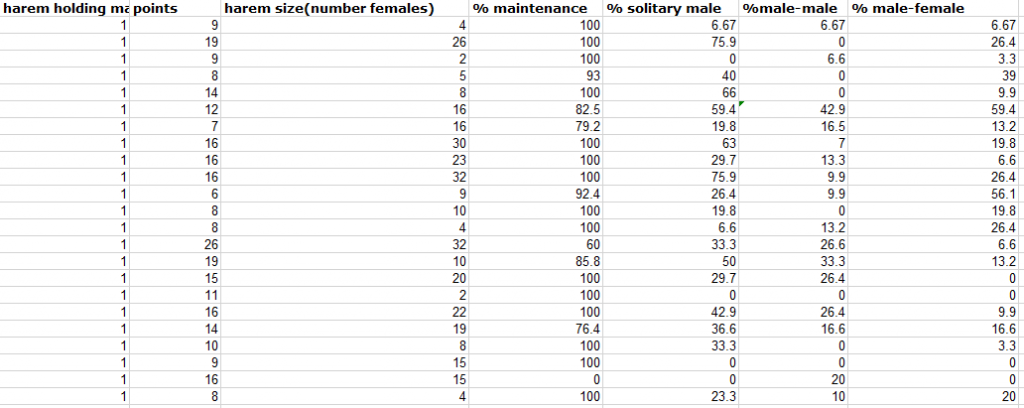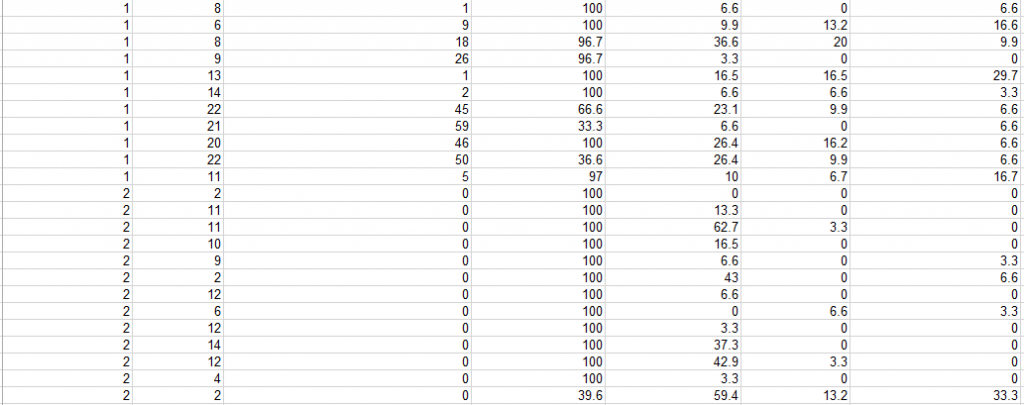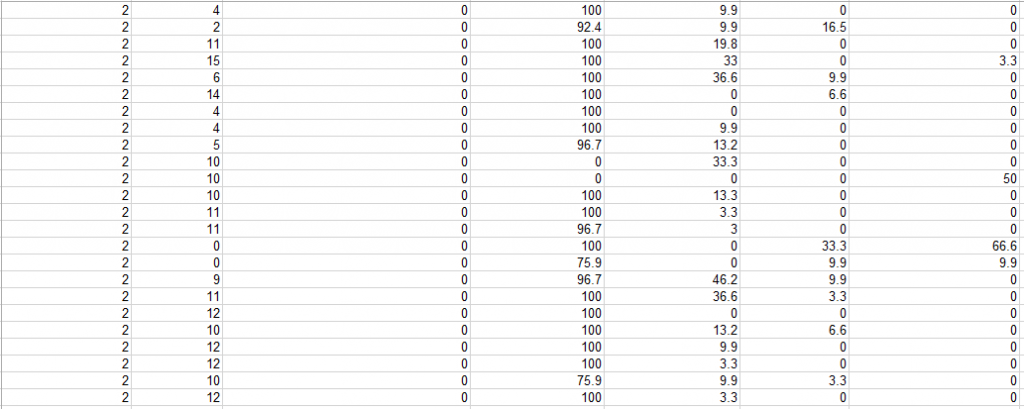Understanding Behaviour-Red Deer Behaviour
Alternative work
Please write a short scientific paper as your report.
Including: Title, Abstract, Introduction, Methods, Results/ Discussion, and References.
The length should be short (ONE SIDE A4 ONLY,
Title: Does the antler size and behaviour of harem holding red deer differ from that of non-holding red deer in the rutting season? Discuss this with reference to vigilance and other behaviours.
Please note that you need to look at the following:
- The data that you need. Available on Moodle as an excel file.
- Further details of the behavioural definitions and the methods that were used to collect the data. These are given below.
- Details of how to write the report and useful references (given below).
The aim of this report is to answer the following questions about red deer stags:
- Is there any relationship between harem size and antler size?
- Do harem-holding stags have different sized antlers than non-harem holding stags?
- Do harem-holding stags behave differently from non-harem holding stags?
- Is there any relationship between harem size and behaviour?
Your report should include the following:
Abstract
A summary of the whole report- write this last!
Introduction
- Short introduction to the literature
- Aims of the study
- Hypotheses to be tested (present as null hypotheses only)
Methods
- What was done
- Sampling methods used -how & why
- Ethogram (very brief)
- Statistical analyses carried out
Results
- Results
- Use SPSS or similar package- if you do the statistics by hand it will take a long time!
- Think about how to present the results so that they don't take up hundreds of pages!
- Present results in summary tables/graphs
- DO NOT CUT AND PASTE DIRECTLY FROM SPSS RESULTS SHEETS
NB. Your results section should answer all 4 of the questions listed above.
Before you start you need to consider
- Are the data parametric or non-parametric?
- What statistics test for differences between two groups (i.e. harem holders vs. non harem-holders)?
- What statistics test for relationships between variables (i.e. harem size vs. number points or harem size vs. % each type of behaviour)?
Discussion
Discuss your results and how they relate to the ideas in the discussion
Bibliography
- All references listed should be cited in the text
- Similarly all cited references should be listed
- Use the Harvard referencing system- marks will be lost if you don't do this properly
N.B.
Check spellings
Find out the difference between it's and its
Put species names in italics or underline
Some example references: (there may be other journal and book sources, plus general texts on animal behaviour).
Carranza, J., Alvarez, F. & Redondo, T. (1990) Territorially as a mating strategy in red deer,Animal behaviour 40: 79-88
Clutton-Brock, T.H. & Albon, S.D. (1979) The roaring of red deer and evolution of honest advertisement, Behaviour, LXIX, 3-4
Clutton-Brock, T.H. & Albon, S.D. (1980) Antlers, body size and breeding group size in the Cervidae, Nature 285: 565-567
Clutton-Brock, T.H. & Albon, S.D. & Gibson (1979) The logical stag: Adaptive aspects of lighting in red deer (Cervus elaphus). Animal Behaviour 27: 211-255
Clutton-Brock, T.H., Guinness, F.E. & Albon, S.D. (1982) Red Deer: Behaviour and ecology of two sexes, Edinburgh University Press.
Goldspink, C.R. (1987) The growth, reproduction and mortality of an enclosed population of red deer in N.W. England. J Zool. Lond. (1987) 213: 23-44
Gibson, R.M. & Guinness, F.E. (1980) Behavioural factors affecting male reproductive success in red deer (Cervus elaphus). Animal Behaviour 28: 1163-1174
McComb, K.E. (1987) Roaring by red deer stags advances the date of oestrus in hinds. Nature. 330 648-649
McComb, K.E. (1991) Female choice for high roaring rates in red deer, Animal Behaviour 41: 79-88
Staines, B.W. (1991) Red Deer, In Corbet, G.B. & Harris, S (eds) (1991), The Handbook of British Mammals, Edn. 3. Blackwell, Oxford: pp. 491-504
For methodological discussions see:
Martin, P. & Bateson, P. (1993), Measuring Behaviour. Cambridge University Press.
Behavioural definitions and methods
The data provided are for red deer stags in Richmond Park, collected in October (the rutting season). The data were collected by the use of one-zero sampling with each stag being watched for 20 minutes. At the start of each sample the deer were recorded as being ‘harem-holding’ or Non-harem holding’. The size of the antlers was estimated by counting the number of antler ‘points’ and, for harem holders the number of females associated with the male was recorded.
Every minute the behaviour of the deer were scored. If one of the following behaviours had occurred in the past minute the behaviour was given a ‘tick’.
N.B. As this is one-zero sampling more than one behaviour can occur in a minute, hence the total percentage of behaviours scored for any one animal can add up to more that 100%. E.g. a stag could be observed to perform both male-male interactions and maintenance behaviour in a single minute.
Behaviours were recorded as falling into one of the following 4 categories:
| Behaviour | Includes the following: |
| Maintenance | Feeding, Standing, Sitting, Lying, Locomotion |
| Solitary male rutting | Dunging, Roaring, Barking, Thrashing, Wiping |
| Male-male | Approaches, Displaces, Parallel walk, Initiates contact, Fight, Chases |
| Male-female | Flehman, Sniffing, Licking, Herding, Chivying, Mounting. Being licked |
You should use these data to test the following hypothesis
Harem holding red deer will differ from non-holding red deer in their antler size and behaviour.
To do this you need to look at the following specific questions
- Is there any relationship between harem size and antler size in red deer?
- Do harem-holding stags have different sized antlers than non-harem holding stags?
- Do harem-holding stags behave differently from non-harem holding stags?
- Is there any relationship between harem size and behaviour?
Full details of the practical protocol used are given below.
PRACTICAL: OBSERVATION OF RED DEER BEHAVIOUR DURING THE RUT
Aims of the Practical
Richmond Park has a large, accessible population of 250-300 red deer (Cervus elaphus) which are maintained at an ‘adult’ (2 years +) sex ratio of 2 males: 5 females. There are also a similar number of fallow deer (Dama dama) in the park. Students will observe the behaviour of the deer during the rut as an introduction to the study of social and sexual behaviour in the field. Field observations will form the basis of a practically based account in which personal observations will be analysed and discussed in the context provided by the findings of published studies of red deer behaviour. If the class is too small, or conditions are too poor to collect adequate data a pre-prepared data set will be provided to supplement the class data.
General Introduction to Red Deer
Red deer are easily distinguished from the other species found wild or feral in Britain by size and colour, basically rusty-brown with a white-buff rump patch. Only the males (stags) have large branching non-palmate antlers which increase in size with age and condition. The females (hinds) are smaller than the males and the calves are marked with light spots on the back but are nevertheless distinguished from other species by the rump patch (rather insensitively called the ‘target’) – as described in the lecture.
The “rut” takes place in late September/early October although stags become increasingly intolerant of each other from late August onwards. Hormonal changes leading to the onset of sexual behaviour are cued by environmental factors such as photoperiod, the changing odour and behaviour of conspecifics and previous rutting experience. Stags compete fiercely for control of hinds in harem groups. Contests between stags are frequent, especially during the period of peak conception, and fights involve serious risk of injury.
Practical Procedure
You will be in pairs or small groups. Each group will be responsible for taking records of the behaviour of animals in and around a harem group.
WARNING – Deer, especially stags, are potentially dangerous!
Stay in your group, NEVER APPROACH THE DEER. Observe at a safe distance (about 100m) using binoculars. If a stag gets up from a lying down position as you approach, orientates to you face-on, or starts to move towards you, appear to lose interest and carefully retreat. Do not stress the deer by suddenly appearing from behind vegetation, waving objects or making loud noises (eg shouting). You should be safe if you use common sense.
Accidents: Your tutor will be carrying a basic first aid kit and a mobile phone.
Emergencies: Contact the police office (on foot or using phones at road gates) at Holly Lodge.
Equipment: Red deer behaviour record sheets (prepared in advance), pencils and notepaper.
Binoculars (bring your own or ask for a School of Life Sciences pair)
Timer (Wrist-watch or ‘phone)
All-weather clothing & sensible footwear – for rough walking.
First Aid kit (Tutor will bring this), mobile phone if you have one.
Instructions: Having located a suitable harem group of red deer:-
- Observe (using the binoculars) and describe the group. Clearly label each behavioural observation record sheet used with your group names/number and other relevant field details. Note especially:
- The number of hinds and young animals per harem
- Stag antler size (no points) and overall condition of stag.
- Observe behaviour of the stag (s) – check with list of defined behaviours.
- Use 30s ‘bleed’ tapes (may need to change time period if there is too little or too much activity)
Take a harem-holding stag as the focal animal and record the presence or absence
of behaviours (1/0 sampling) listed on your ethogram during each of thirty 30s
periods (15 minutes in total).
- DURING the 15 minute observation period, keep additional records of:
- The No. of challenges your focal stage is involved with.
- The No. of roars, the number of times he sits down in apparent rest or feeding.
- Movements of hinds and the degree to which the stag herds them.
- Any other behaviour you find noteworthy.
- NOW REPEAT your 15 minute observation for another stag which has no harem. You will later be able to compare their behaviour with the harem-holder.
- Now you have two 15 minute samples. Repeat the exercise with another two stags.
Your group should aim to end the morning with 4 fifteen-minute observation sheets filled – representing an hours recording of stag behaviour split between two harem holders and two non-harem holders.
If you find that you have only time to do three observations, buddy-up with another group to ensure even numbers of harem-holding and non-harem holding males in the sample.
Data Collection & Analysis
- For each 15 minute observation session:
For each behaviour category: note the number of times it was recorded as occurring during the 30 thirty-second periods. Express this as a % occurrence value.
eg Stag A roared in 19 of the 30 observation periods.
thus “Roaring” had a 63.3% occurrence for this stag.
Transfer data to the Summary Data Sheets provided. (PLEASE WRITE CLEARLY IN BLACK INK)
- Use both your own group data and personal notes in combination with the class data to consider the following questions:
- Is there a relationship between harem size and any features of the harem-holding stag and its behaviour?
eg Size and condition of stag
No. of fights with other stags
Occurrence and frequency of roaring, parallel walking, etc.
- Does harem-holding affect the stag’s feeding or other maintenance behaviours?
- What is/are the most appropriate method(s) of behavioural monitoring?
- Write up and discuss your results in the usual format for an experimental write up. The account must contain an Abstract, Introduction, Method, Results, Discussion and Reference list, must make use of appropriate descriptive and inferential statistical analysis, and must make adequate reference to the relevant literature in your introduction and discussion.


Summary of rutting behaviour of stags: adapted from Clutton-Brock. T.H., et al (1982) Red Deer Behaviour & ecology of two sexes, Edinburgh University Press
ROAR – deep guttural roar – may be aggregated into bouts of one to ten that are often given on the same exhalation.
BARK – a series of short barks typically directed at young stags after they have been chased away.
THRASH – the stag rakes the ground/vegetation with his antlers, often spraying the area he is thrashing with urine and subsequently rolling on it.
WIPING – harem-holding stags commonly rub their chins, antler pedicles, or preorbital glands on outstanding “landmarks” e.g. posts and rocks.
APPROACH – where one stag moves to within 100m of another.
DISPLACE – stags displace young stags or rivals that approach their harems by walking steadily toward them so that they then retreat.
PARALLEL WALK – after one stag has approached another, the pair may move into a tense walk in which they move parallel to each other, typically 5-20m apart. At this stage their hair is often raised, and their gait is slow, regular and stiff.
INITIATE CONTACT – one stag lowers his antlers, inviting contact. Antler joining often follows quickly.
FIGHT – the two stags lock their antlers and push to and fro, occasionally disengaging, until one individual is driven rapidly backwards.
CHASE – stags chase yearlings, young stags, etc. away from their harems by running directly at them, often chasing them to over 100m from the harem. Chase terminates when the harem-holder turns back to his harem. Stags often end a chase with a scissors kick of the forelegs followed by roaring.
FLEHMEN – after sniffing a hind or the place where a hind has urinated, stags may raise their heads and curl back their upper lips.
SNIFF & LICK – stag approaches lying hinds and lick the back of their heads and necks, gradually working over the head towards the preorbital region. This may be followed by an attempt to sniff and lick around the base of the tail. Bouts may last several minutes – usually ended by the hind moving away. The stag may then sniff and lick the grass where the hind has rested and, maybe, urinated. The stag can detect pheromones released in the urine.
HERD – stags often head off hinds on the edge of the group that are attempting to leave their harems by walking outside them, head held high, with a stiff, prancing gait. The stags head is typically at an angle to the direction of movement with eyes half closed. If the hind persists in trying to leave, the stag may threaten her with lowered antlers or give a brief scissors kick with his front legs and may bark at her.
CHIVY – stags frequently chase hinds over short distances within their harems. The stag trots after the hind with neck outstretched, sometimes extending his tongue. Chivies end when the stag stops, apparently losing interest, and they are often followed by a bout of roaring.
MOUNT – only hinds in oestrus allow the stag to mount. Mating sequences usually involve several mountings over a period of up to an hour or more. Ejaculation is easily identified by a sudden thrust that jerks the stag’s body upright, often throwing the hind forward several paces.
WALLOW – the stag wallows in muddy area, often also urinating into it and wiping his antorbital glands and antlers on nearby vegetation.
DATA





